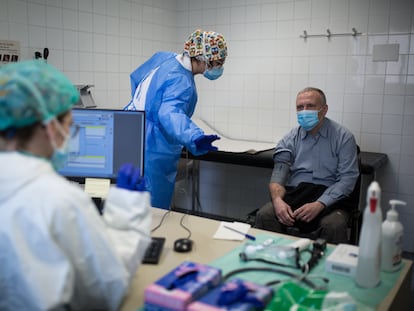Thousands stranded on ‘China’s Hawaii’ due to Covid outbreak
In order to leave Hainan island, travelers must present five negative tests within the space of seven days

Thousands of tourists are stranded in the Chinese coastal city of Sanya due to an outbreak of Covid-19 cases. The city, which is located on the island of Hainan, recorded more than 1,200 new cases between August 1 and 8. In keeping with its zero-Covid policy, the Chinese government ordered on Sunday the lockdown of Sanya, which is home to nearly one million people. On Monday, the lockdown was extended to nine other areas of the island, affecting a total of seven million people. In order to leave the island, a person must present five negative PCR tests carried out within a week.
During the first two years of the pandemic, Hainan – which is known as “China’s Hawaii” – was a popular tourist destination for those seeking to escape harsh lockdown rules on the mainland. While authorities in the province initially managed to contain the virus, the sudden surge of cases has put authorities on alert.
“When my mini-vacation was over, they canceled my flight,” said Renato Parraguez, a Chilean living in Beijing, from Sanya. “We went from 13 cases when I arrived, to 500 in two days,” he explained by phone. “I have to be locked in my hotel for seven days. They have blocked everything, it is impossible to leave Hainan,” he said.
China continues to follow a strict zero-Covid policy, despite the negative impact it has had on the economy, especially after the harsh two-month lockdown of Shanghai in spring. In addition to isolation and mass testing, the country has kept its borders practically closed and all travelers from abroad must spend at least seven days in a hotel room upon arrival.
With the strict restrictions preventing travel to beaches in Southeast Asia, the southern island of Hainan (located off the coast of Canton) has been the preferred getaway destination for Chinese residents, due to its mild tropical climate, range of outdoor activities – from surfing to hiking – and large number of luxury resorts. The place has seen a boom in tourism, especially among foreigners, given the difficulty of traveling to other countries.
Last year, the province – the smallest in China – recorded just two asymptomatic cases of Covid-19. But between August 1 and 8, 2,079 infections were registered, according to figures provided by China’s National Health Commission. Most of the patients have symptoms and are in Sanya, where 1,200 cases have been detected.
On Saturday, Sanya authorities canceled all flights and trains in the city, and put the province in “temporary static management,” which involves the suspension of public transportation services, the closure of non-essential businesses and the confinement of residential complexes. The city’s deputy mayor, He Shigang, told state television CCTV that around 80,000 tourists were on vacation in Sanya when the lockdown was announced. Of this figure, 40% of them are trapped in their hotels. Sanya International Airport confirmed on Tuesday that all flights to and from the Sanya remain canceled. It is not known when flights will resume.
“We understand the inconvenience caused to travelers and ask for understanding and support,” said Ye Kaizhong, deputy secretary of Sanya’s municipal government, at a press conference on Sunday. Even though authorities have promised to help stranded visitors with room costs, many are struggling to make ends meet. According to the official announcement, hotels will be required to offer customers a 50% discount until the restrictions are lifted.
But Parraguez believes that this doesn’t compensate for price hikes. “Prices have varied between €400 and €700 a night,” he explained. “Many customers are now paying much more than during their stay, because they originally booked the room with a discount.” He says, however, that he has been lucky: he is located away from the source of the contagion, in an area that has become a “bubble.” “I can still go to the beach that is within the perimeter of the resort and access the hotel bar,” he explained.
Many of the foreigners stranded in Sanya have taken to social media to criticize the lack of information from authorities. Health authorities announced that travelers must submit five negative PCR tests within seven days in order to leave Hainan, but there is no sign that canceled flights will resume by the end of this week. It is estimated that this latest lockdown will affect a total of seven million people. The provincial capital, Haikou, with almost three million inhabitants, as well as eight other regions of the island, asked their residents on Monday not to leave their homes unless strictly necessary.
Health officials reported that the latest outbreak was caused by the BA.5.1.3 subvariant of omicron. This is the first time that this mutation has been detected within the borders of China. Local media have blamed the Covid spike on “an illegal fishing boat from Vietnam,” as the first infected patient was a fish seller who suspected that “he was infected while trading with foreign fishermen on the high seas.”
Tu suscripción se está usando en otro dispositivo
¿Quieres añadir otro usuario a tu suscripción?
Si continúas leyendo en este dispositivo, no se podrá leer en el otro.
FlechaTu suscripción se está usando en otro dispositivo y solo puedes acceder a EL PAÍS desde un dispositivo a la vez.
Si quieres compartir tu cuenta, cambia tu suscripción a la modalidad Premium, así podrás añadir otro usuario. Cada uno accederá con su propia cuenta de email, lo que os permitirá personalizar vuestra experiencia en EL PAÍS.
¿Tienes una suscripción de empresa? Accede aquí para contratar más cuentas.
En el caso de no saber quién está usando tu cuenta, te recomendamos cambiar tu contraseña aquí.
Si decides continuar compartiendo tu cuenta, este mensaje se mostrará en tu dispositivo y en el de la otra persona que está usando tu cuenta de forma indefinida, afectando a tu experiencia de lectura. Puedes consultar aquí los términos y condiciones de la suscripción digital.
More information
Últimas noticias
From Andorra to Gibraltar, a black market for Ozempic exploits its success: ‘They’re the most sought-after products in the world’
Magnets in their heads: How some animals guide themselves using the Earth’s magnetic field
From Hungary’s Orbán to Chile’s Kast: How Trump helps turbo charge the far right
The brief rise and retreat of Generation Z in Mexico
Most viewed
- Why we lost the habit of sleeping in two segments and how that changed our sense of time
- Trump’s obsession with putting his name on everything is unprecedented in the United States
- Charles Dubouloz, mountaineering star, retires at 36 with a farewell tour inspired by Walter Bonatti
- The Florida Keys tourist paradise is besieged by immigration agents: ‘We’ve never seen anything like this’
- Living in a motorhome due to soaring housing prices in Madrid: ‘I got used to it quickly, but I don’t idealize it’











































